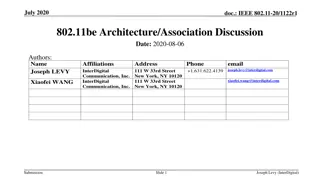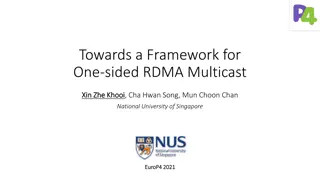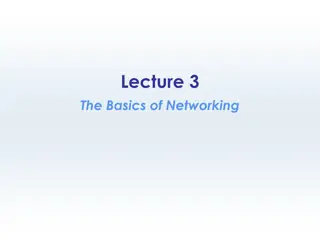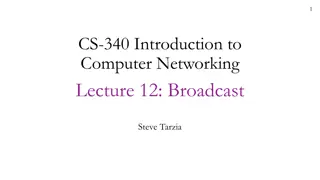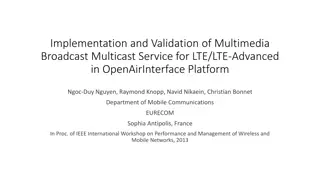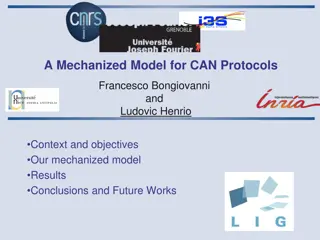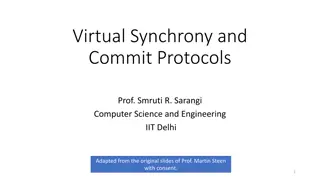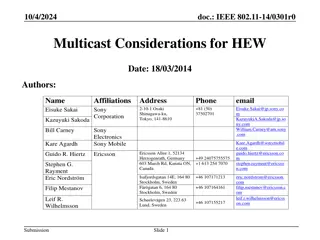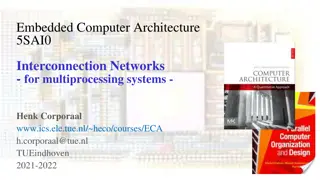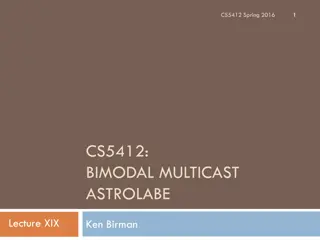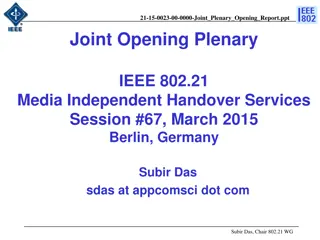MAAP Protocol Overview in IEEE 1722: Address Acquisition and Message Format
The MAAP (Multicast Address Acquisition Protocol) is defined in IEEE 1722 for time-sensitive applications in bridged local area networks. It involves acquiring multicast addresses through claiming, probing, and defending messages. MAAP enables dynamic allocation of addresses and defending against co
0 views • 8 slides
Distributed Computation in Node-Capacitated Networks
Exploration of communication primitives and algorithms in node-capacitated networks, including Node-Capacitated Clique Model, communication on butterfly networks, orientation using Boruvka's algorithm, computing O(a)-orientation, and solving graph problems like BFS trees, maximal independent set, ma
0 views • 7 slides
IEEE 802.11be MLD Architecture Discussion
The document discusses the architecture of MLD (Multicast and Local Delivery) within the IEEE 802.11be framework. It highlights how MLD will align with existing 802.11 basic architecture, emphasizing the management of access to PHY and media for both AP and non-AP devices. The goal is to integrate M
0 views • 9 slides
Understanding Delegates in Unreal Engine
Delve into the world of delegates in Unreal Engine, from basic to dynamic and multicast types. Discover how delegates enable flexible function assignment and callback mechanisms within classes. Explore examples like player events and asset processing to grasp the power and versatility of delegates i
1 views • 18 slides
Framework for One-sided RDMA Multicast in Data Center Group Communications
This paper explores the implementation of one-sided RDMA multicast in data center group communications, highlighting the benefits of offloading network I/O from CPUs and unique connection parameters for efficient multicast operations. The research addresses the challenges of enabling one-sided RDMA
0 views • 11 slides
Understanding Project Calico: Networking Essentials and Future Trends
Explore the pivotal role of Project Calico in networking, focusing on its core concepts, including IP connectivity, multicast, and broadcast, along with a deep dive into the data path mechanisms. Discover the future prospects and use cases that highlight its provisioning and isolation capabilities w
0 views • 16 slides
Basics of Networking Communication and Internet Structure
The content covers the basics of networking communication, including synchronous and asynchronous communication, broadcast, multicast, and point-to-point communication. It also discusses internet properties, client/server structure, and interactions in client/server relationships. The visuals provid
0 views • 39 slides
Understanding Computer Networking: Broadcast and Multicast Protocols
In this lecture on computer networking, we explore the concepts of broadcast and multicast protocols. The discussion covers topics such as BGP routing, IPv4 anycast hack, IP multicast, and the role of broadcast in small-to-moderate sized ad hoc networks. Learn about the differences between unicast,
0 views • 20 slides
Implementation and Validation of Multimedia Broadcast Multicast Service for LTE/LTE-Advanced
This study discusses the implementation and validation of a multimedia broadcast multicast service for LTE/LTE-Advanced using the OpenAirInterface platform. It explores the motivation behind enhancing multimedia capabilities in high-capacity mobile networks and the challenges related to previous res
0 views • 28 slides
Mechanized Model for CAN Protocols - FASE 2013
This research paper presents a mechanized model for Content Addressable Network (CAN) protocols, focusing on supporting RDF data storage in the Semantic Web. It discusses the general motivation, CAN principles, RDF queries, and challenges in handling queries over variables in large-scale settings. T
0 views • 26 slides
Implementation and Demonstration of eBCS Concept in IEEE 802.11-19/1999r0
This presentation showcases the implementation and demonstration of the eBCS concept, including the system architecture, utilization of eBCS AP and STA, web server functionality, and data transmission processes. It covers the use of LDPC-Staircase/Triangle for packet transmission, IP multicast for d
0 views • 9 slides
Broad Architectural Principles in System Design
The role of broad architectural principles in system design is crucial for creating large-scale systems. Researchers must define goals and assumptions while considering performance, elegance, and iterative design processes. Understanding critical-path driven processes helps optimize system efficienc
0 views • 50 slides
Local MAC Address Assignment Protocol (LAAP) and 802.1CQ
The Local MAC Address Assignment Protocol (LAAP) in conjunction with 802.1CQ specifies protocols and procedures for locally unique assignment of MAC addresses in IEEE 802 networks. LAAP operates in two modes - Server Mode and Peer-to-Peer Mode, ensuring efficient allocation of MAC addresses while av
0 views • 15 slides
Understanding Virtual Synchrony and Commit Protocols in Distributed Systems
Explore the concepts of virtual synchrony, commit protocols, and reliable multicasting in distributed systems. Learn about one-to-one communication, process groups, and virtually synchronous multicast, along with implementations in LAN environments. Discover how processes can handle failures and ens
0 views • 23 slides
Multicast Considerations for High Efficiency Wireless (HEW) Networks
Discusses the unique characteristics and challenges of distributing the same content to a large number of devices in dense deployment scenarios, focusing on multicast communication. Emphasizes the need for efficient solutions in HEW to enhance multicast communication for scenarios such as video dist
0 views • 14 slides
Interconnection Networks in Multiprocessing Systems Overview
Explore the intricacies of interconnection networks for multiprocessing systems in Embedded Computer Architecture, covering connecting processors, topologies, routing, deadlock, switching, and performance metrics like bandwidth and latency. Delve into various network types, such as on-chip networks
0 views • 33 slides
Efficient Gossip and Bimodal Multicast Protocols in Distributed Systems
Gossip protocols are vital in spreading information efficiently in large systems, with log(N) time complexity for dissemination. Bimodal multicast uses IP multicast for message transmission, lacking reliability and flow control. The cost of IP multicast is low, but ensuring reliability can be achiev
0 views • 49 slides
IEEE 802.21 Joint Plenary Opening Report
The presentation discusses the objectives, work status, and task group activities of IEEE 802.21 related to handover services and interoperability between heterogeneous networks, focusing on multicast group management and revision projects. The report outlines the session schedule and future plans f
0 views • 7 slides


